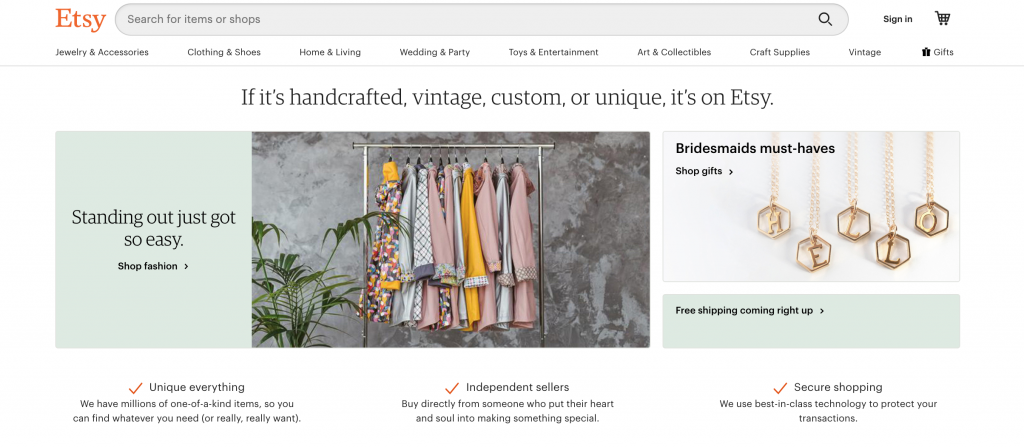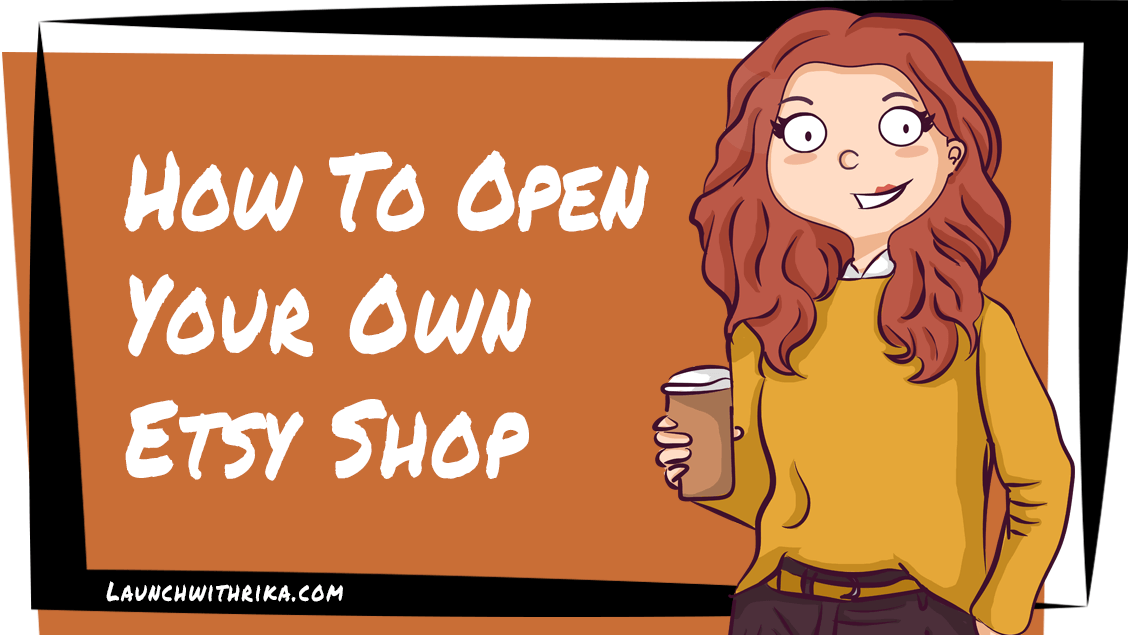Etsy is a great way to get your name out to audiences who care about the time and craftsmanship that you put into your products. It’s a user-friendly platform that can help connect you with people who prefer a unique touch to their home, personal style, gifts, and more.
In this article, we’ll give you the step-by-step info you need to know how to start an Etsy shop.
- How Does Etsy Work
- List of Etsy Fees
- Prep Work To Opening Your Etsy Shop
- How to Set Up an Etsy Shop
- How to Drive Traffic To Your Etsy Shop
- Day-to-Day Management
How Does Etsy Work?
Etsy is an online marketplace that specializes in unique, handcrafted or otherwise one of a kind products made by independent sellers. Etsy helps give independent sellers a shared platform to reach audiences who care about getting a high level of craftsmanship or personalization.
Etsy is simply a platform on which you’d sell your products. Otherwise, you work directly with your customers to communicate order details and manage your shipping, returns, and exchange policies.

List of Etsy Fees
Etsy runs by charging several fees for using the platform. Knowing these fees early can help you determine the cost of your product and how you’ll list it.
The main Etsy fees you should be aware of are for listing, shipping, transaction, payment processing, transaction fees, and a few others.
Listing Fee
The listing fee is how much it costs for you to put up an item in your store. It’s $0.20 for each listing, and listings expire every four months. This fee is required regardless of how many products you sell under that listing. You can set certain listings to auto-renew, so you don’t have to remind yourself every four months.
Shipping Label Fees
These fees will depend on what you select when you purchase your shipping labels.
Transaction Fees
The transaction fee is 5% of the total item (plus shipping and gift wrap) in your listing currency.
Etsy Payments Processing Fees
If you use Etsy Payments, they’ll charge a processing fee. For the United States, this fee is 3% plus 0.25 USD – but it’ll vary by country.
Additional Fees (Dependent on Your Location & Activity)
Additional fees that may apply include VAT fees, currency conversion fees, and other fees incurred by long-distance or international shipping. Some fees are incurred on a special basis, like if you choose to run Etsy Ads.
The Four-Step Prep Work to Opening an Etsy Shop
Now that you have an idea of what to expect from Etsy’s fee structure, let’s move on to getting your shop started. You’ll need to choose your product, photograph it, and prepare your shop name and branding materials. If you have these four things prepared, opening your shop will be a breeze.
Choose Your Products
First things first – you need to decide which products you’ll sell. Etsy is committed to remaining a unique marketplace – so you’ll need to follow their guidelines to be eligible to sell on their platform. The main points to know are:
- Handmade items must be made or designed by you. If you have a partner or employees, that must be disclosed in the relevant listings.
- You must use your own photographs. For example, stock images, renderings, or images of similar products can’t be used.
- For a product to be considered vintage, it must be at least 20 years old.
- Craft supplies must be handmade, vintage, or commercial. It’s strongly encouraged that you explain where your materials come from and how your supplies are produced.
As a quick rundown of what to avoid, you should steer clear of anything that promotes the use of drugs and alcohol, dangerous items, items for adult audiences, and anything that relates to hate or violence. Etsy offers great advice on what counts as a prohibited item and what is acceptable.
Take Beautiful and Enticing Photos
Once you’ve nailed down your offering, it’s time to take beautiful photos of your products. Make sure your products are shown in bright and clear lighting. Don’t forget to be creative and include images of your product in use or in a themed setting.
When you open your shop – these are suggested photos you should have to show off your product. The more photos, the better. These little details can help your shop stand out, especially if you’re in a crowded category.
For listing images, ensure that your file is 2000px for the shortest side of the image, has a 4:3 aspect ratio, and has a resolution of at least 72ppi. For easy uploading, your photo shouldn’t exceed 1 MB in size. Having a bright and high-quality photo is important since your product images will be shrunk to thumbnails on the search results page.
Don’t forget to preview your listing so you know everything looks just right.

Name Your Game: Choose the Name of Your Shop
Now that you’ve decided what to sell, you can come up with a name that reflects your brand and products. If you are just starting out, it’s best to go with a name that is unique and descriptive. For example, if you sell homemade planters, you could try the name: HappyPlantHome. Names like this let you show off your personality while also helping you appear in related search results.
Whichever name you choose, make sure that the domain name and social media accounts are available in case you’d like to expand your online presence or move away from selling on Etsy.
When making your shop – don’t forget that your account name is different than your shop name. It’s recommended that your account name is your real name. If you ever choose to manage a second Etsy shop under the same account, you won’t cause confusion to your customers or to yourself while managing two different stores.
Design Elegant Branding
Now that you’ve chosen a shop name, it’s time to design visuals to support your branding. You’ll need a shop icon, profile photo, and a shop banner. The shop icon and profile photo should both be 500 by 500 pixels. The banners vary by size: the small banner should be 1600 by 213 pixels, and the large banner should be 1600 by 400 pixels.
With everything prepared – it’s time to open your Etsy shop doors! Here’s a walkthrough of how to open your Etsy Shop.
How to Set Up an Etsy Shop – Step by Step
First, visit the Etsy homepage. In the top right corner, it’ll say, “Sell on Etsy.” It’ll then direct you to an informative page that answers common questions. Click the button that says, “Open Your Etsy Shop.” Once you register (which only requires a name, email address, and new password) – you’ll begin the process.
You’ll go through several stages, titled: shop preferences, name your shop, stock your shop, how you’ll get paid, and set up billing.
Shop Preferences
In this section, you’ll fill out basic information about your shop. This includes where you’ll be based, your preferred currency, and the language you plan to operate in.

Name Your Shop
Once you get to ‘name my shop’ – you can input your shop name and check for its availability. Going with our example from earlier, this is what it’ll look like when you input a name that works. Try to prepare several names that you’d be happy with.
Before you make a final decision, check that your choice isn’t too close to a competitor’s shop name. For example, you’d want to avoid being “HappyPlantHome” if a major competitor is called “HappyPlanterHouse.”

Stock Your Shop
The next step is to stock your shop. Etsy requires you to have at least one listing ready to go in order to open your shop. Good thing you’ve got everything prepared from earlier!
Go ahead and upload at least one listing, including your high-quality images, product descriptions, and other information you’ll need.

Finally, it’s time for the nitty-gritty details – getting paid for your hard work. In the ‘how you’ll get paid section, you’ll be asked standard banking questions such as your address, routing and account number, and social security number. Here are a few of the questions below:

Finally, you’ll set up billing information to complete the process. This information helps Etsy charge you for the fees we mentioned earlier.
Voila – It’s that simple to set up your Etsy shop. Of course, there’s always more to be done. Be sure to update your about page, write your shipping, returns, and exchange policies, and manage other branding details.
Now that your shop is up and running, it’s time to start getting the word out.
How to Drive Traffic to Your New Etsy Shop
Before you worry about bringing in external traffic, it’s important to make sure that you’re being found by people already browsing your category on Etsy.
Etsy Traffic
The top two things you can do to improve your Etsy search result luck is to optimize your tag and title relevancy as well as selecting relevant product attributes. Tags and attributes work together, so it’s better if you optimize both.
For tag and title relevancy, make sure you max out your tags so you appear in a range of related product categories. Try to name your products so that they’d appear as an exact match in a search result. Finally, using similar keywords in your tag and title help reinforce to the algorithm that your product is a match, and will rank it higher as a result.
Next, you should take the time to select relevant product attributes. These attributes work together with the algorithm to understand your product. Attributes can include color, size, occasion, holiday, and more.
External Organic Traffic & Paid Traffic
To bring in external traffic, make sure you’re promoting your Etsy shop on all your social media platforms. Pinterest, Instagram, and Facebook are all great places to promote your craft, show off your products, and share promotional codes and discounts. Do a quick search on Google Trends and Google Ads to see what the popular search terms are for your product.
Finally, consider doing a shop launch countdown and teasing what products you’ll be offering. Build some hype around your shop and get people excited to browse. Make sure to do an exciting announcement once your shop is open!
If you feel like you’re always reaching the same few people – consider using Etsy Ads to promote certain listings or new offerings.
Day-to-Day Management of Your Etsy Shop: Customer Service, Handling Issues, and Vacation Mode
Running a successful Etsy shop is a big undertaking. Even once it’s off the ground, there are a few things you should always keep an eye on to ensure you have happy customers on the other end.
It probably goes without saying that customer service must be at the forefront of your eCommerce business. Although Etsy connects you to a larger audience, you’re still in charge of managing their experience. Take the time to ask for feedback from your customers and see if there’s a way to make your ordering process go even more smoothly.
Keep your lines of communication open. Work to ship your products on time – and when you can’t, communicate early so your customer doesn’t feel left in the dark. Do what you can to keep them in the loop, such as offering tracking numbers and estimated delivery dates.
If a product arrives broken or isn’t what they had hoped, make sure you have a rock-solid returns and exchanges policy that protects both you and your customer from disappointment.
Finally, put your store in vacation mode when you can’t tend to your shop, or need a moment to catch up on backorders. It’s always better to see that a store is in break mode than getting ready to check out and having your purchase fail.
Etsy has a way to ‘favorite’ stores, so don’t worry. Loyal fans can use this feature to monitor your shop and will get in touch when you’re back in action.
Conclusion
People love Etsy because it’s a great way to connect with artisans from around the world. Customers on Etsy enjoy getting the handmade touch without the hassle of finding a craftsperson and comparing prices.
As a shop owner, I know you’ll bring your A-game to stand out from the crowd and design a memorable shop with beautiful products. I hope this guide helped you figure out what you need to have prepared to get your Etsy shop off the ground.
Have any questions about starting your own Etsy shop? Leave them in the comments below – I’d love to help.







